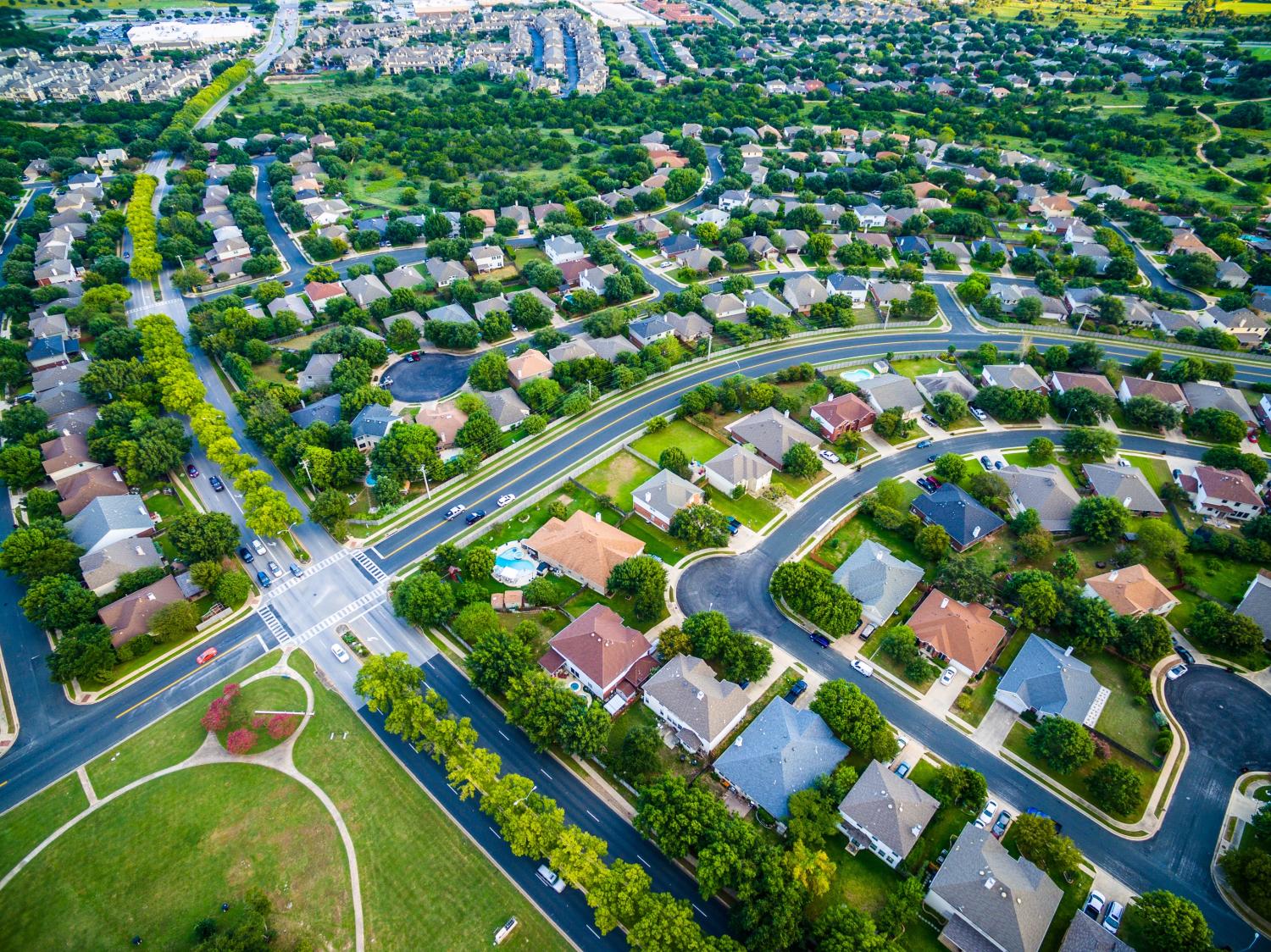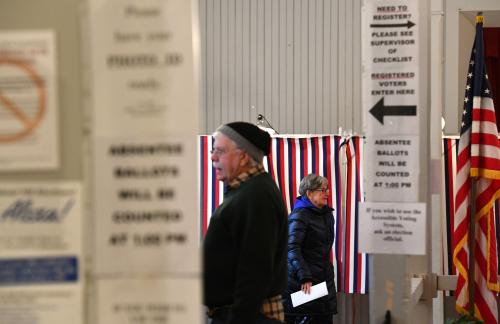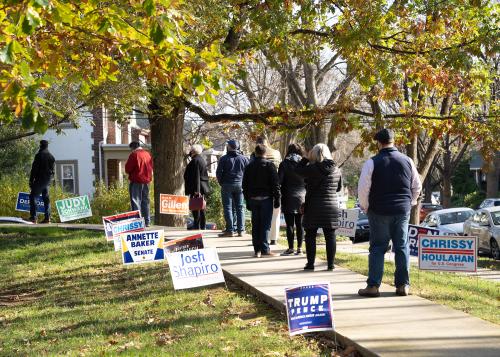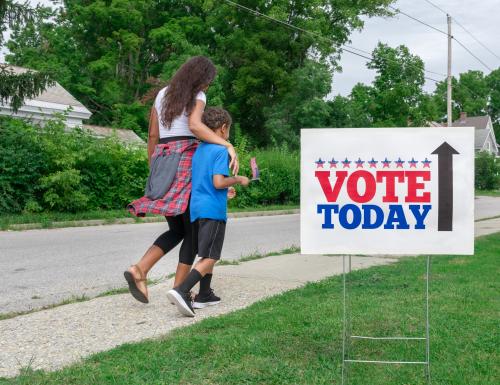In the 2016 election, rural and nonmetropolitan America gave Donald Trump enough of a margin to beat Hillary Clinton in seven key states. Ahead of the 2020 election, Republicans worried that Trump would lose his rural edge, in light of reduced support there in the 2018 midterm elections. But this was not the case. Instead, Trump’s loss to Joe Biden was due mostly to voters in large metropolitan suburbs, especially in important battleground states.
That is the primary conclusion from this analysis of 2020 presidential votes using a Brookings Institution classification of U.S. counties by urban status. It shows that suburban counties and smaller metropolitan areas strongly contributed to Biden’s victories in the key states of Michigan, Pennsylvania, and Wisconsin, as well as his competitive showing in Georgia. Nonmetropolitan counties did not move far, if at all, from their strong 2016 support of Trump.
Democrats retake the suburbs
America’s suburbs have always been highly contested, given the historically strong Democratic support in big cities and Republican support in rural areas. In recent presidential elections, suburban and small metropolitan areas have tended to show a net advantage to Republicans. The issue for Democratic candidates became how far they could cut into the Republican vote margins in rural, small metropolitan, and, especially, suburban areas.
Figure 1 depicts Democratic minus Republican (D-R) vote margins in recent presidential elections for counties classed by urban status.* (The D-R vote margin is defined as the percent voting Democratic minus percent voting Republican, where a positive value shows a net Democratic advantage and a negative value shows a net Republican advantage.)

In each presidential election since 2008, urban core areas showed strong Democratic vote advantages, while small metropolitan areas and nonmetropolitan areas voted Republican to different degrees. Nonmetropolitan areas showed especially outsized Republican advantages in Trump’s 2016 victory, and his 2020 margin there stood at a whopping 34%.
However, large suburban areas in 2020 registered a net Democratic advantage for the first time since Barack Obama’s victory in 2008. This is significant because more voters reside there than in the other three categories. In terms of aggregate votes in these large suburban counties, there was a shift from a 1.2 million vote advantage for Trump in 2016 to (at last count) a 613,000 vote advantage for Biden—a nearly 2 million vote flip. In addition, Biden benefitted from more modest Republican margins in small metropolitan areas. These advantages for the President-elect were even greater in key battleground states.
The suburban vote mattered in Michigan, Pennsylvania, and Wisconsin
The three northern battleground states of Michigan, Pennsylvania, and Wisconsin—which flipped to Trump in 2016—again entered the Democratic fold in 2020. Here, even more than in the national analysis, the 2016 to 2020 suburban shifts to either greater Democratic or smaller Republican support were instrumental in Biden’s victory. See Figure 2 and Downloadable Tables A and B.

Michigan’s swing from Trump to Biden had much to do with shifts in several suburban counties. In these counties, Trump’s substantial seven point margin in 2016 changed to an almost even Democratic-Republican split in 2020. This—along with greater Democratic gains in urban cores and small metro areas—more than countered Trump’s still large nonmetropolitan margins. The near erasure of Trump’s 91,000 suburban vote lead from 2016 played an important part in his Michigan defeat.
Noteworthy shifts in Michigan came from counties in the Detroit suburbs, including Oakland County (which showed an increase in Democratic support since 2016), and Macomb and Livingston counties, which registered smaller Trump vote advantages than in the last election. Counties in smaller metropolitan areas—including Grand Rapids, Lansing, Ann Arbor, and Kalamazoo—also showed greater Democratic or lower Republican support.
Pennsylvania was a closer win for Biden. Here, he depended heavily on lower Republican margins in suburban and small metro areas than in 2016. This, along with strong support from urban cores, allowed him to overcome continued Trump strength in rural areas.
The suburban Philadelphia counties of Montgomery, Bucks, Delaware, and Chester increased their existing Democratic advantages from 2016. In contrast, most counties in suburban Pittsburgh registered net Republican advantages—but generally less than in 2016. Particularly noteworthy for Biden was greater support (or less of a deficit) in the northeastern part of the state, including the Allentown and Scranton/Wilkes-Barre metropolitan areas, as well as Harrisburg.
In Wisconsin, as with the nation as a whole, Biden’s win relied on his performance in suburban and smaller metropolitan counties. The 2020 election saw lower Republican margins in Milwaukee’s suburban counties—Waukesha, Ozaukee, and Washington—and gains in counties within Madison’s metropolitan areas. The vast majority of the state’s 46 nonmetropolitan counties voted for Trump in both 2016 and 2020, with his margins in most of them increasing.
Suburban shifts in the Sun Belt
Suburban voting patterns also made a difference in the Sun Belt, especially in large southern states where suburbanization has been rampant. The focus here is on two such states: Georgia, where Biden is ahead and a recount has been announced; and Texas, which Trump won, but where urban and suburban voting patterns closed the longtime Republican-Democratic gap. See Figure 3 and Downloadable Tables A and B.

A Democratic presidential candidate has not won Georgia since Bill Clinton took the state in 1992. Yet its demographic shifts—including brisk growth in the state’s Democratic-leaning Black population, gains in Latino or Hispanic and Asian Americans voters, and an increase in white college graduates, especially in the Atlanta metropolitan area—served to make the state competitive for Democrats this year.
Georgia’s urban core counties (including several close-in Atlanta counties that are sometime thought of as suburbs) helped the 2020 result swing toward Democrats. The counties of Fulton, DeKalb, and Clayton have consistently voted Democratic in recent elections. The populous counties of Gwinnett, Cobb, and Henry flipped to voting Democratic in 2016, and increased their Democratic margins even more so this year. Other suburban counties that showed increased Democratic support since 2016 were Douglas, Newton, and Rockdale.
While a large number of smaller suburban counties in the Atlanta metro area voted for Trump in 2016 and 2020, Republican margins shrank in most of them this year. A similar result occurred in the state’s small metropolitan areas. Thus, both urban and suburban Georgia look stronger for Democrats, despite still solid Republican support in nonmetropolitan Georgia, which saw a 40% Trump margin.
Texas has voted for Republican presidential candidates since 1976. But, as with Georgia, it has long been seen as a potential Democratic flip in light of its changing demographic make-up. Today, white eligible voters comprise just half of the state’s electorate.
Trump held on in Texas this year, but his margin was smaller. The reason had to do with changes in urban and suburban counties around the state’s largest metropolitan areas. Using the Brookings urban classification system, Trump barely won large suburban counties and lost fairly substantially in urban cores.
In the Dallas metropolitan area, Dallas County registered larger Democratic gains than in previous elections, while the populous counties of Tarrant, Collin, and Denton showed sharply reduced Republican margins, as did much of the rest of the Dallas suburbs. This was also the case for many counties in the Houston, San Antonio, and Austin metropolitan areas. (See Downloadable Table B.)
Small and nonmetropolitan areas in Texas continued to vote strongly Republican in 2020. But the demographic shifts taking place within the state’s metropolitan areas—especially its suburbs—stand to make it even more competitive in future elections.
Georgia and Texas are not the only Sun Belt states experiencing a shift of urban and suburban votes to Democrats while rural areas remain Republican. It is also occurring in North Carolina and Arizona, where the populous urban-suburban county of Maricopa is largely responsible for Biden’s strong showing. In Florida, however, suburban voters did not resister enough gains in 2020 to counter the state’s continued nonmetropolitan Republican strength or the decreased Democratic support in Miami.
The future for Democrats is in the suburbs
In many ways, the 2020 election could represent a breakthrough for Democrats in the sense that the suburbs—along with continued urban core support—could make them competitive both in familiar “blue wall” states as well as yet-to-be-conquered Sun Belt states.
This past election might have also been unique given that Trump’s rural Republican base (including white noncollege voters) stayed with him, while suburban white women moved even more so in the opposite direction. As the nation’s demography becomes more diverse in terms of race, age, and educational attainment, the growing Democratic-leaning voting blocs are likely to comprise even greater shares of the suburban electorate—cementing the importance of the suburbs in elections to come.
*This classification of U.S. counties, developed by the Brookings Metropolitan Policy Program, depicts urban cores and large suburbs within the 100 largest metropolitan areas, as well small metropolitan and nonmetropolitan counties.







